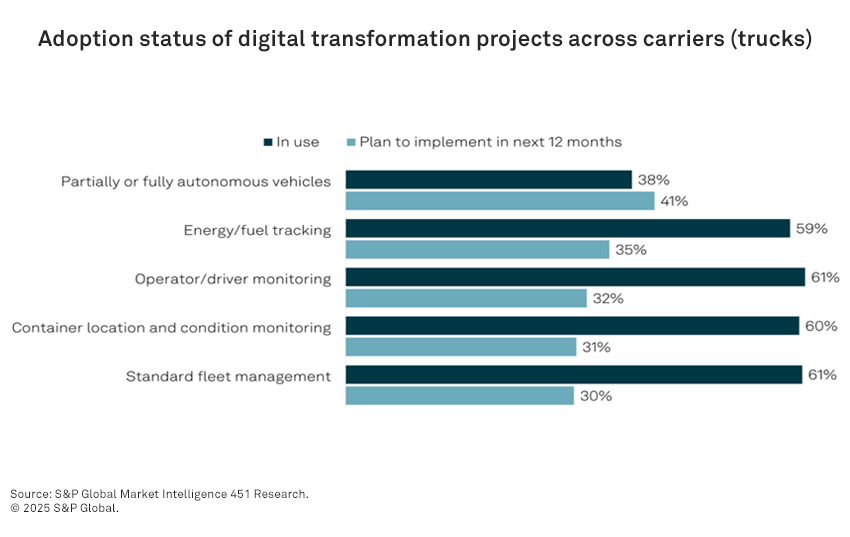
Source: Tramino/iStock/Getty images.
The electrification of commercial fleets is at the forefront of the global shift toward sustainable transportation. This transformation extends beyond merely updating vehicles; it involves a comprehensive overhaul of the supporting infrastructure, including charging stations and grid readiness. As the transition from residential to nonresidential electric vehicle charging infrastructure (EVCI) progresses, new approaches and technologies are essential to support high-capacity fleet charging hubs and corridor infrastructure.
Electrification of commercial fleets
The electrification of commercial transport is accelerating, driven by the deployment of electric heavy-duty vehicles (eHDVs), medium-duty trucks, buses, delivery vans and autonomous shuttles.
In the heavy-duty vehicles segment, 53% of carriers are transitioning to electric vehicles (EVs) and another 33% plan to within the next year, according to a survey conducted by S&P Global Market Intelligence 451 Research.
These figures refer to carriers engaged in electrification efforts — at various stages of maturity — not the percentage of EVs currently on the road. The chart illustrates the level of engagement, not the actual fleet composition.
By 2050, it is projected that more than 320,000 truck chargers will be required across regional trucking and transport corridors.

Regulatory landscape and market drivers
In Europe, the regulatory framework is playing a significant role in advancing EVCI. The EU’s Alternative Fuel Infrastructure Regulation mandates the installation of fast chargers every 60 km along the TEN-T core network. Additionally, the European Commission’s Clean Transport Corridor initiative aims to streamline permitting, prioritize grid access and de-risk investments. In contrast, the US faces challenges due to policy volatility, with programs like the National Electric Vehicle Infrastructure and Charging and Fueling Infrastructure shaping the landscape. Despite these challenges, private-sector depot electrification continues to progress.
Grid readiness and technology integration
The electrification of commercial transport places substantial demands on the grid, necessitating upgrades and proactive planning. Utilities are encouraged to adopt advanced technologies such as digital twins and AI-based forecasting to optimize grid performance. The integration of internet of things (IoT) technology is crucial for creating a smart, scalable ecosystem that aligns with strategic priorities across the grid, fleet operators and energy providers. IoT enables real-time communication between charging systems, distributed energy resources and grid assets, allowing for efficient orchestration of energy flows and asset performance.
Emerging charging technologies and models
New technologies and deployment models are redefining EVCI. Depot electrification is scaling, with logistics and transit operators converting depots into high-capacity charging hubs. Public and private fast-charging corridors are expanding, supported by a mix of government funding and private investment. These corridors are often colocated with gas stations and logistics hubs, catering to long-haul freight, intercity buses and passenger EVs. Urban charging for fleets, wireless charging and bi-directional charging (vehicle-to-grid) are in various stages of development, each presenting unique opportunities and challenges for modernization.
Cybersecurity and resilience
As EVCI becomes critical national infrastructure, it must adhere to cybersecurity and resilience standards such as the NIS2 Directive and ISO 15118. This designation introduces new dimensions, requiring enhanced regulatory oversight and planning coordination. Charging systems must be robust against cyberthreats and capable of maintaining operational resilience under diverse conditions. The importance of cybersecurity and resilience cannot be overstated, as these systems are integral to the functioning of national infrastructure.
Investment and funding strategies
Funding initiatives like the Alternative Fuels Infrastructure Facility in Europe are crucial for supporting EVCI deployment. The facility has allocated significant resources to accelerate the buildout of charging points, including high-capacity chargers for eHDVs. In contrast, the US faces uncertainty due to policy shifts, but this also opens up opportunities for flexible, modular approaches tailored to state and private deployments. The role of private investment is increasingly critical, as policy volatility presents challenges for public funding.
The role of grid technology vendors
Grid technology vendors are evolving from traditional equipment suppliers to full-spectrum transformation partners, offering integrated hardware, software and systems for EVCI. Their capabilities span planning, deployment and real-time grid optimization. Key vendors include Siemens AG, ABB Ltd., ADS-TEC Energy PLC, Alfen NV, ChargePoint Holdings Inc. and Schneider Electric SE. These vendors are investing in self-healing grid technologies, automated fault detection and substation digitalization to manage the volatility introduced by high-capacity EV charging.
Conclusion
The electrification of commercial fleets is not merely a technological upgrade but a structural shift that demands coordinated action across regulators, utilities, technology providers and fleet operators. As demand accelerates, the transition to a sentient grid will be essential to power a sustainable, electric future for freight and fleet mobility. This evolution presents a unique opportunity for industrial technology vendors to shape the future of energy and mobility infrastructure, positioning them as key partners in this transformative journey.
Want insights on smart car technology and automotive industry trends delivered to your inbox? Join the 451 Alliance.
This content may be AI-assisted and is composed, reviewed, edited and approved by S&P Global in accordance with our Terms of Service.

